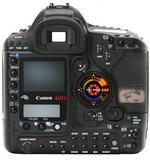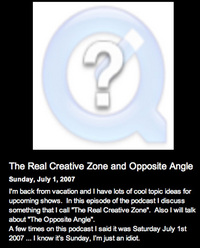"Correction"
Last week in my segment called "The Real Creative Zone" I made a mistake in terminology ... I got the camera's creative zones and basic zones mixed up.
When I was talking about the camera modes with the little icons, like landscape, portrait, macro, etc I called them the creative zones ... those settings are actually called the basic zones or image modes.
When I was talking about shutter priority, aperture priority, Manual, etc I should have been calling them the creative zones.
Everything I said was as I meant it in the podcast, except getting these two terms reversed.
So what I said still goes, try getting away from the little icon modes (aka basic zones") and try using the other modes like Aperture Priority, Shutter Priority, Manual Etc.
"Travel tips for photographers"
"Never Czech Your Bags"
On my recent trip I traveled with my Lowepro Vertex 200 AW backpack and a standard suitcase. I carried most of my camera gear in the backpack and kept it with me on the plane, only a few items went into my suitcase.
,,,that is until the trip home. After 2 weeks of traveling I was getting tired of the heavy backpack and I packed more of my camera gear and my laptop in my suitcase for the trip home. In the suitcase was my
Canon 30D body
Canon 70-200mm f/2.8 L IS
Canon 50mm f/1.2L
Canon 15mm Fisheye
My new tripod
The dual charger for my 1D Mark III
and my 15" Apple MacBookPro laptop computer.
So we left Prague on Czech Airlines heading for Paris (Via Rome) for a one night stay before heading back to the states. Upon arriving at Charles De Gaulle airport in Paris we stood at the baggage claim till all the bags came out and were claimed .... ours were not there!!!!!!!!
So there we were standing there at 11pm at the Paris airport wondering what to do next and I was adding up in my head what the replacement cost of all those lenses, the camera body and the laptop would be and I was not liking the answer I was coming up with.
My partner had lots of goodies in his bag as well, nothing as expensive as all my camera stuff, but lots of souvenirs and even the car keys for the car that was waiting for us in the parking lot at Ontario Airport in California.
The only things in my backpack were my new 1D Mark III, my 100-400 L IS and few other small items including the portable hard drive that all my vacation pictures were on (at least I was thinking when I packed that with me).
To make a long story short, my bag eventually ended up arriving at my house about a week later in perfect condition with all my goodies safely inside, my partner Mike's bag arrive a week after that also in great shape and untouched. We were very lucky.
I am what you might call a seasoned traveler ... I've flown domestically a hundred times over my lifetime and flown to Europe about 10 times in the last 7 years .... but at the end of a long vacation even someone with a lot of travel experience can get lazy and stupid and make mistakes.
The obvious moral to this story is NEVER put your valuables in your checked baggage ... and never check a bag on a czech airline :)
"How to travel"
Now lets talk about how to travel ... specifically within Europe or any other continent.
You're thinking, what do you mean How? Well normally when we take a vacation we don't stay in one place the whole time, we will stay a few days in one place and then move on to another ... this way we get to see a lot more of a country, region or continent.
So what's the best way to do this? and what's the best way for a photographer to do this? You normally have two primary choices for moving distances out of reasonable car or bus range and those would be Plane and Train.
For me the choice is obvious ... once I'm overseas it's trains. There are lots of reasons for this.
1. traveling around Europe by air can cost as much as getting to Europe (or even more)
2. traveling by train allows you to see more of the scenery and offers a lot more flexibility in your travel plans. A given country may have a few major airports, but they will have hundreds or more train stations that you can stop at.
3. Getting back to the previous topic, when traveling by train you are never separated from your luggage.
and 4. often traveling by train is quicker than by air.
Now you are saying to yourself ... Allen you are crazy, planes travel at nearly 600 miles per hour, the fastest trains are about 1/3 that fast.
But wait. Here's an example of a trip I've done both ways. Traveling from London to Paris.
By Air.
Lets look at the trip from the moment you leave your hotel in London to the moment you get to your hotel in Paris
Getting to Heathrow takes about an hour.
Checking in can be another hour
You should be 1-2 hours early for your flight
The flight takes about 2 hrs
Getting off the plane and fetching your bags about another hour
Taking the RER train into Paris and getting to your hotel about another hour
That's a total of 7-8 hours of traveling for a 2 hour flight.
Now by rail
Getting to the train station about 1/2 hr
train trip 2 hrs 45 minutes
fetching your baggage 0
Getting into Paris 0 ... you are already there
Getting to your hotel 1/2 hr max
Total trip time less than 4 hours and you were never separated from your bags and you got to see a lot of countryside (except while in the chunnel) for about $150.00US round trip ... probably less than flying.
Technorati Tags: Digital Photography, Allen Rockwell, Travel


